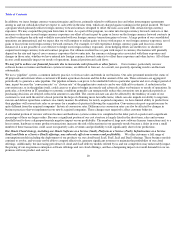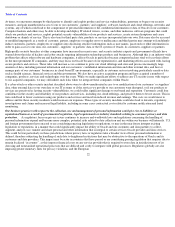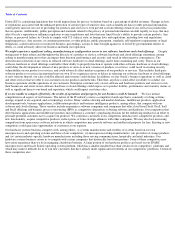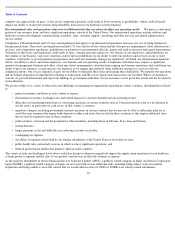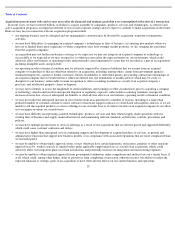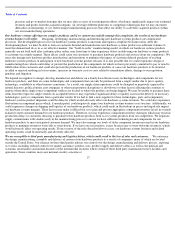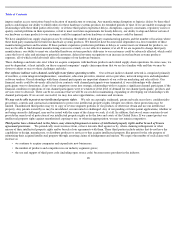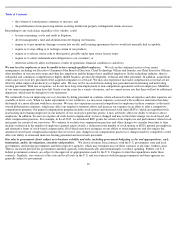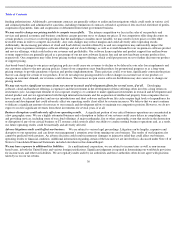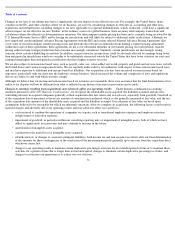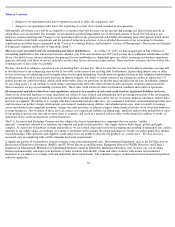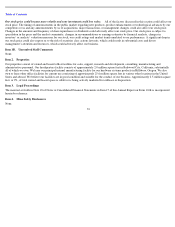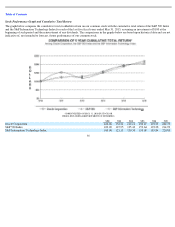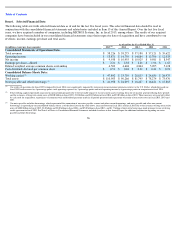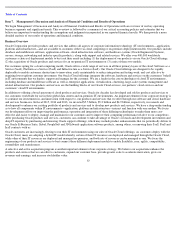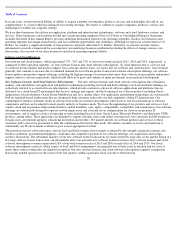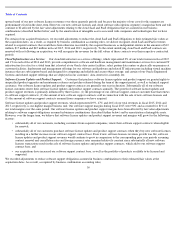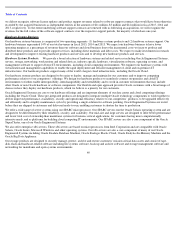Oracle 2014 Annual Report Download - page 34
Download and view the complete annual report
Please find page 34 of the 2014 Oracle annual report below. You can navigate through the pages in the report by either clicking on the pages listed below, or by using the keyword search tool below to find specific information within the annual report.
Table of Contents
funding authorizations. Additionally, government contracts are generally subject to audits and investigations which could result in various civil
and criminal penalties and administrative sanctions, including termination of contracts, refund of a portion of fees received, forfeiture of profits,
suspension of payments, fines and suspensions or debarment from future government business.
We may need to change our pricing models to compete successfully. The intense competition we face in the sales of our products and
services and general economic and business conditions can put pressure on us to change our prices. If our competitors offer deep discounts on
certain products or services or develop products that the marketplace considers more valuable, we may need to lower prices or offer other
favorable terms in order to compete successfully. Any such changes may reduce margins and could adversely affect operating results.
Additionally, the increasing prevalence of cloud and SaaS delivery models offered by us and our competitors may unfavorably impact the
pricing of our on-premises enterprise software offerings and our cloud offerings, as well as overall demand for our on-
premises software product
and service offerings, which could reduce our revenues and profitability. Our software license updates and product support fees and hardware
systems support fees are generally priced as a percentage of our net new software licenses fees and net new hardware systems products fees,
respectively. Our competitors may offer lower pricing on their support offerings, which could put pressure on us to further discount our product
or support pricing.
Any broad-based change to our prices and pricing policies could cause our revenues to decline or be delayed as our sales force implements and
our customers adjust to the new pricing policies. Some of our competitors may bundle products for promotional purposes or as a long-term
pricing strategy or provide guarantees of prices and product implementations. These practices could, over time, significantly constrain the prices
that we can charge for certain of our products. If we do not adapt our pricing models to reflect changes in customer use of our products or
changes in customer demand, our revenues could decrease. The increase in open source software distribution may also cause us to change our
pricing models.
We may not receive significant revenues from our current research and development efforts for several years, if at all. Developing
software, cloud and hardware offerings is expensive and the investment in the development of these offerings often involves a long return on
investment cycle. An important element of our corporate strategy is to continue to make significant investments in research and development and
related product and service opportunities both through internal investments and the acquisition of intellectual property from companies that we
have acquired. Accelerated product and service introductions and short software and hardware life cycles require high levels of expenditures for
research and development that could adversely affect our operating results if not offset by revenue increases. We believe that we must continue
to dedicate a significant amount of resources to our research and development efforts to maintain our competitive position. However, we do not
expect to receive significant revenues from these investments for several years, if at all.
Business disruptions could adversely affect our operating results.
A significant portion of our critical business operations are concentrated in
a few geographic areas. We are a highly automated business and a disruption or failure of our systems could cause delays in completing sales
and providing services, including some of our cloud offerings. A major earthquake, fire or other catastrophic event that results in the destruction
or disruption of any of our critical business or IT systems could severely affect our ability to conduct normal business operations and, as a result,
our future operating results could be materially and adversely affected.
Adverse litigation results could affect our business.
We are subject to various legal proceedings. Litigation can be lengthy, expensive and
disruptive to our operations, and can divert our management’s attention away from running our core business. The results of our litigation also
cannot be predicted with certainty. An adverse decision could result in monetary damages or injunctive relief that could affect our business,
operating results or financial condition. Additional information regarding certain of the lawsuits we are involved in is discussed under Note 18 of
Notes to Consolidated Financial Statements included elsewhere in this Annual Report.
We may have exposure to additional tax liabilities. As a multinational corporation, we are subject to income taxes as well as non-income
based taxes, in both the United States and various foreign jurisdictions. Significant judgment is required in determining our worldwide provision
for income taxes and other tax liabilities. We are regularly under audit by tax authorities and those authorities often do not agree with positions
taken by us on our tax returns.
30


